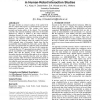Free Online Productivity Tools
i2Speak
i2Symbol
i2OCR
iTex2Img
iWeb2Print
iWeb2Shot
i2Type
iPdf2Split
iPdf2Merge
i2Bopomofo
i2Arabic
i2Style
i2Image
i2PDF
iLatex2Rtf
Sci2ools
HRI
2006
ACM
2006
ACM
Empirical results from using a comfort level device in human-robot interaction studies
This paper describes an extensive analysis of the comfort level data of 7 subjects with respect to 12 robot behaviours as part of a human-robot interaction trial. This includes robot action, proximity and motion relative to the subjects. Two researchers coded the video material, identifying visible states of discomfort displayed by subjects in relation to the robot's behaviour. Agreement between the coders varied from moderate to high, except for more ambiguous situations involving robot approach directions. The detected visible states of discomfort were correlated with the situations where the comfort level device (CLD) indicated states of discomfort. Results show that the uncomfortable states identified by both coders, and by either of the coders corresponded with 31% and 64% of the uncomfortable states identified by the subjects' CLD data (N=58), respectively. Conversely there was 72% agreement between subjects’ CLD data and the uncomfortable states identified by both c...
| Added | 13 Jun 2010 |
| Updated | 13 Jun 2010 |
| Type | Conference |
| Year | 2006 |
| Where | HRI |
| Authors | Kheng Lee Koay, Kerstin Dautenhahn, Sarah Woods, Michael L. Walters |
Comments (0)

